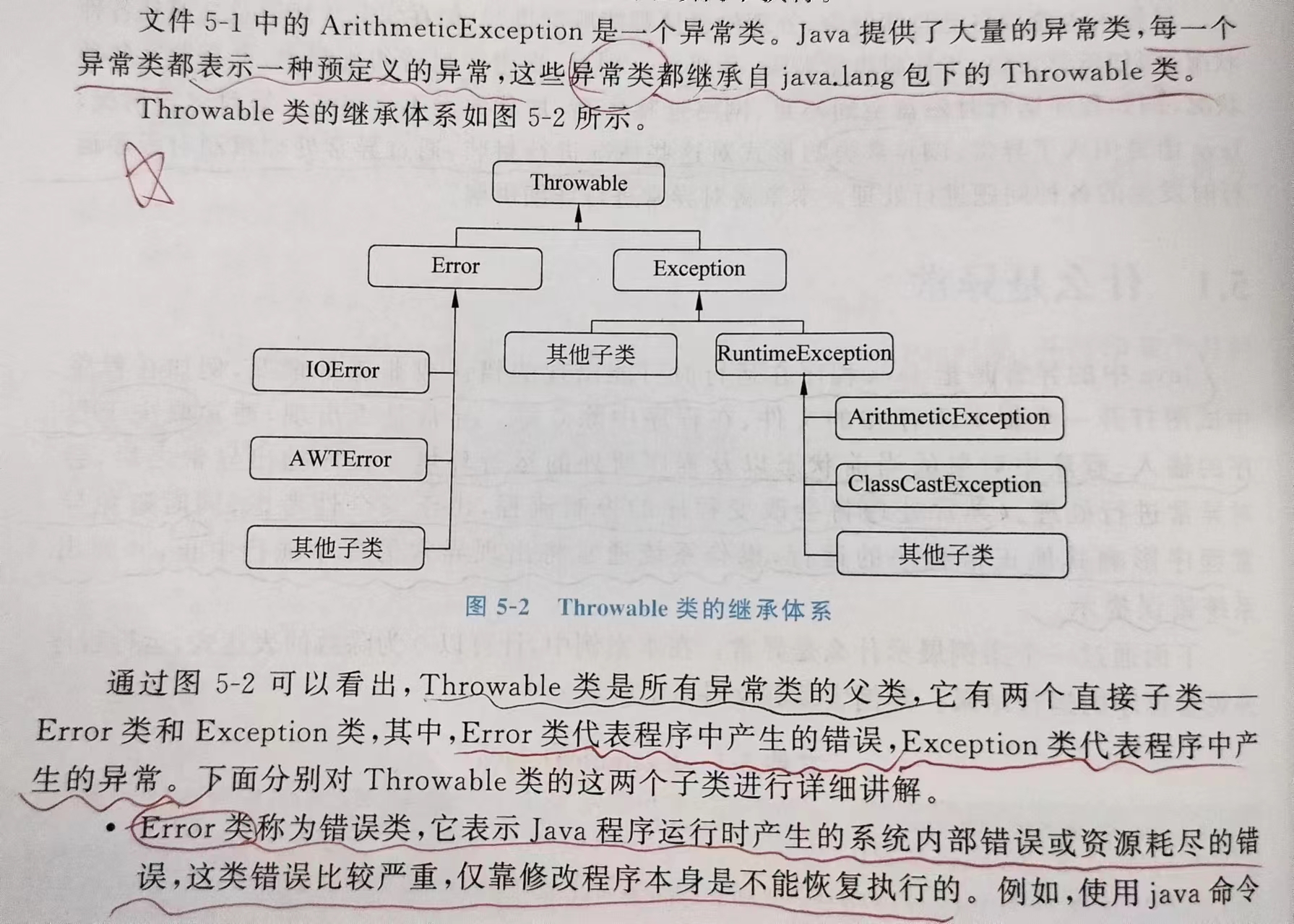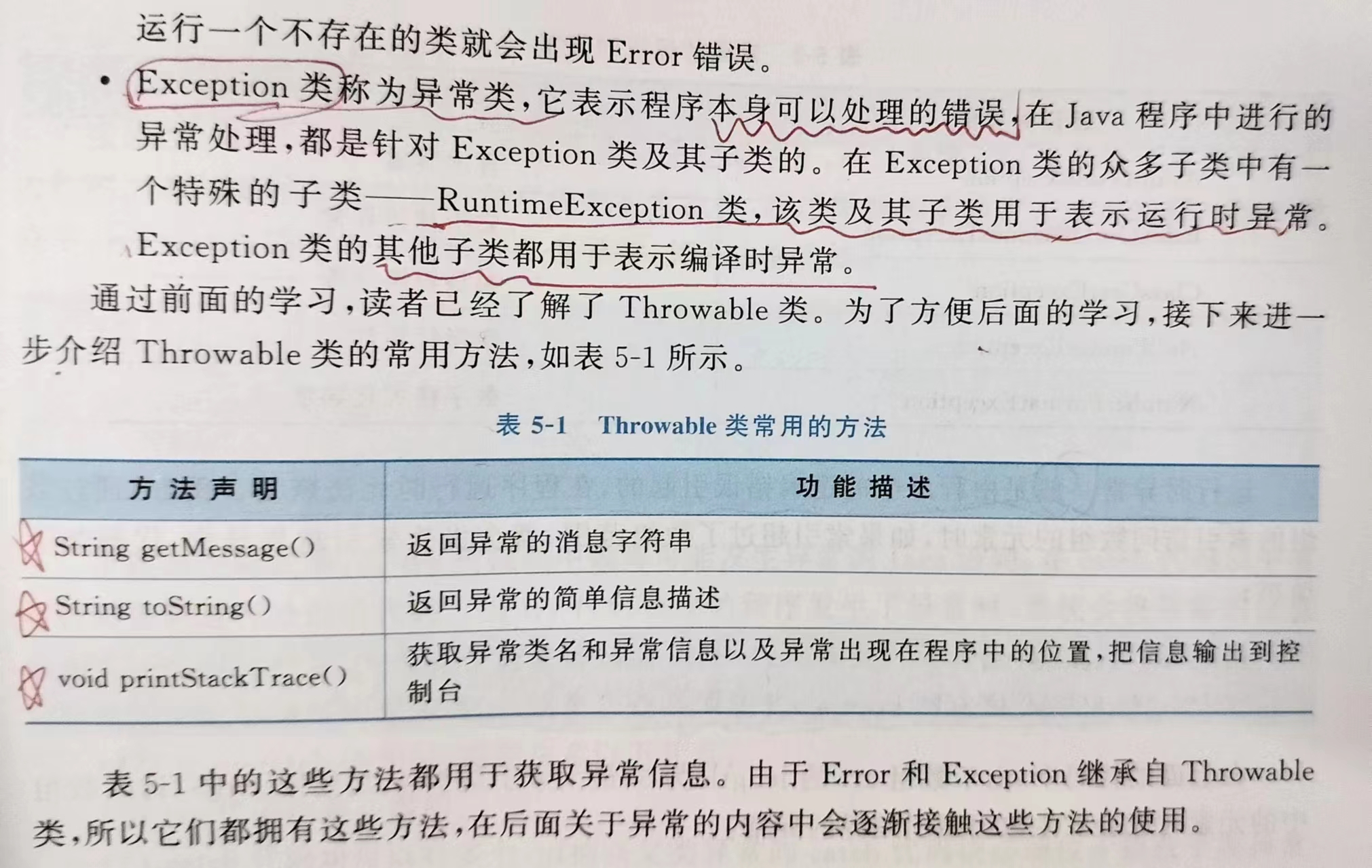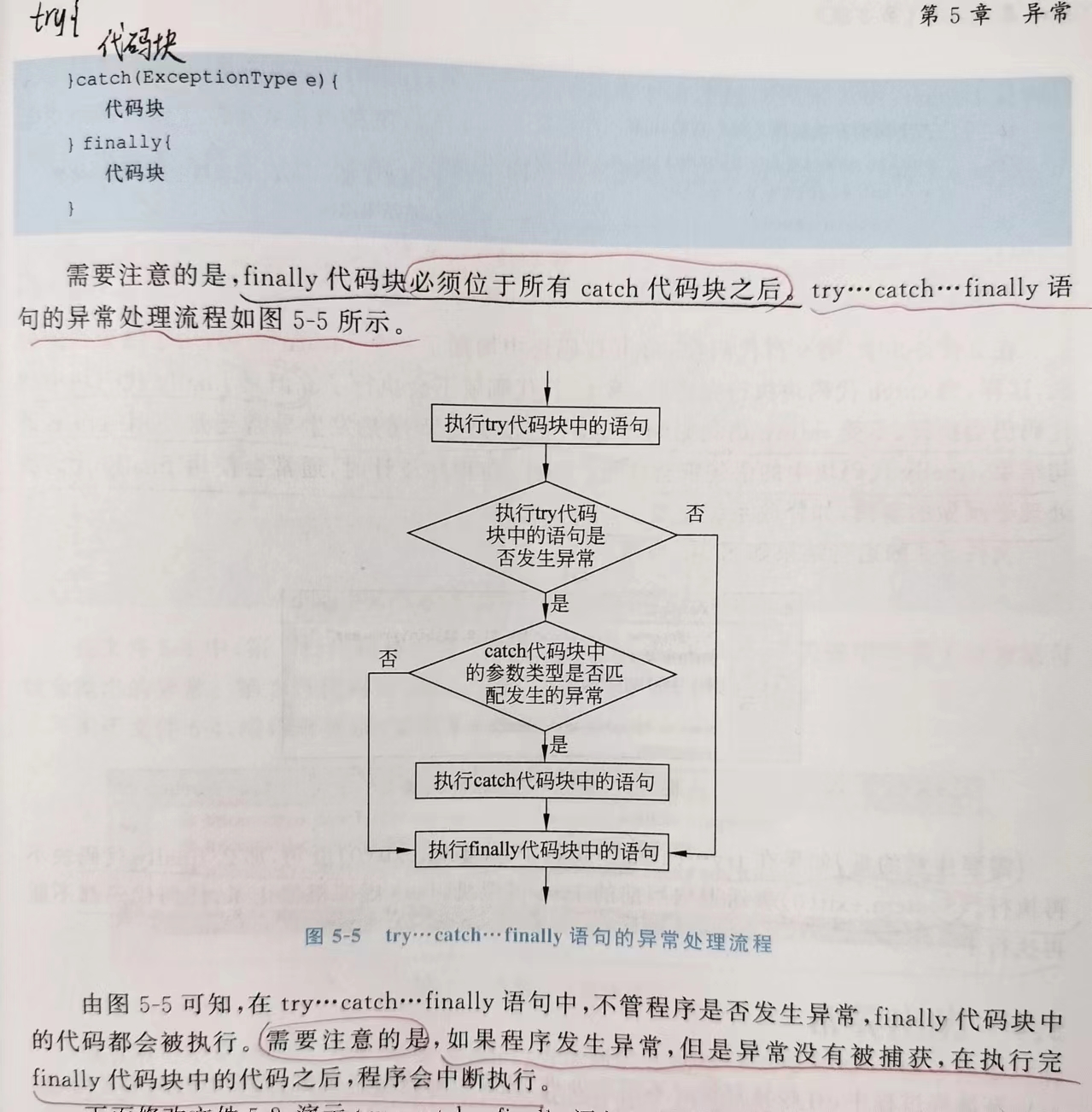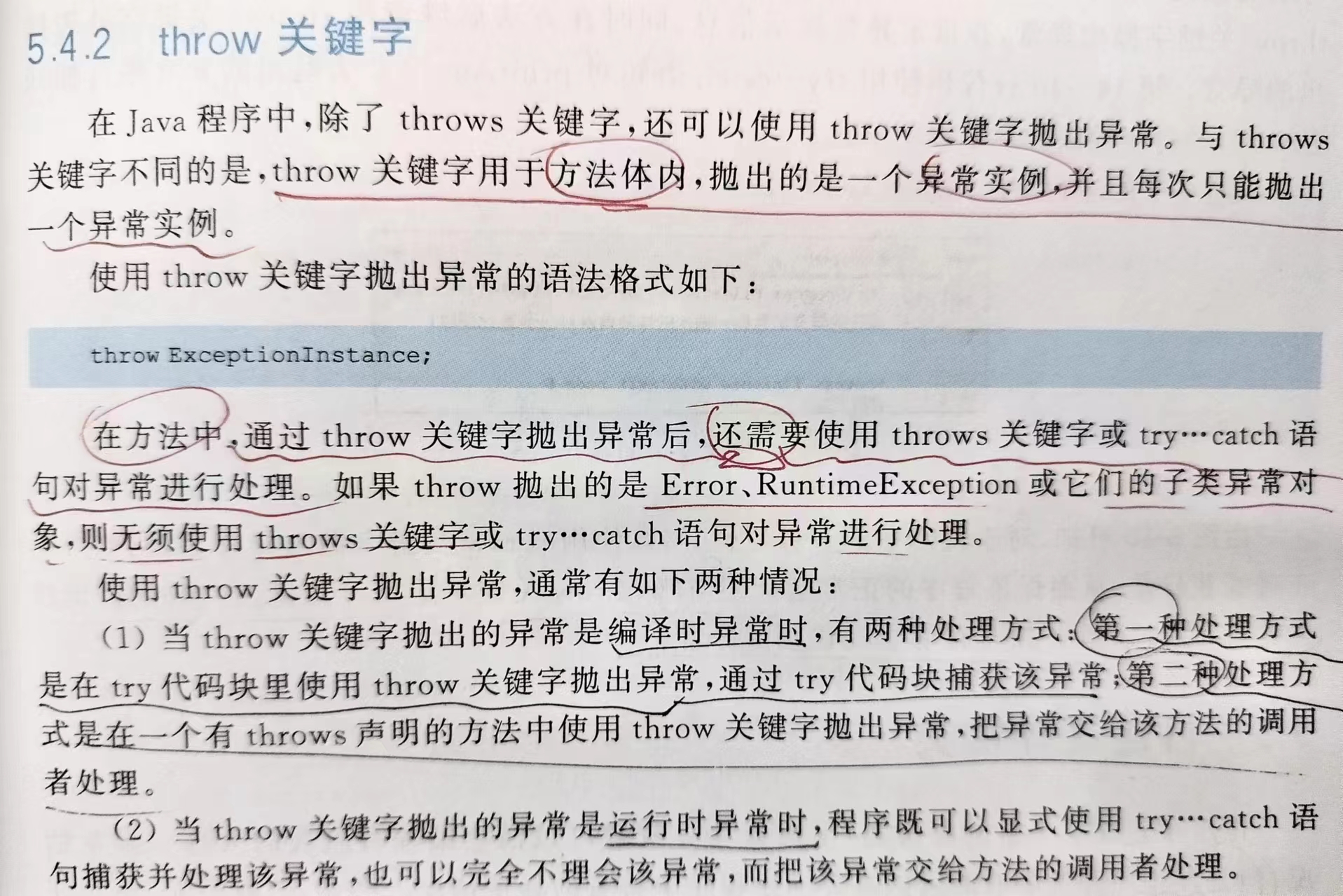
目录
1-1、Throwable类的继承体系、错误类和异常类的介绍
1、异常的概念

public class Example01 {
public static void main(String[] args) {
int result = divide(4, 0); // 调用 divide() 方法,第 2 个参数为 0
System.out.println(result);
}
// 下面的方法实现了两个整数相除
public static int divide(int x, int y) {
int result = x / y; // 定义变量 result 记录两个数相除的结果
return result; // 将结果返回
}
}![]()
1-1、Throwable类的继承体系、错误类和异常类的介绍

 2、运行时异常与编译时异常
2、运行时异常与编译时异常
2-1、两种异常的概念
2-2、常见的运行时异常
 3、异常处理及语法
3、异常处理及语法
3-1、处理异常的五个关键字
3-2、try……catch语句

class Example02 {
public static void main(String[] args) {
//下面的代码定义了一个 try…catch 语句用于捕获异常
try {
int result = divide(4, 0); //调用 divide() 方法
System.out.println(result);
} catch (Exception e) { //对异常进行处理
System.out.println("捕获的异常信息为:" + e.getMessage());
}
System.out.println("程序继续向下执行…");
}
//下面的方法实现了两个整数相除
public static int divide(int x, int y) {
int result = x / y; //定义变量 result 记录两个数相除的结果
return result; //将结果返回
}
}
catch代码对异常处理完毕后,程序仍会向下执行,而不会终止。
需要注意的是,在try代码块中,发生异常的语句后面的代码是不会执行的,例如,上面代码中的第六行的代码(打印语句)就没有执行。
3-3、finally语句


public class Example03 {
public static void main(String[] args) {
//下面的代码定义了一个 try…catch…finally 语句用于捕获异常
try {
int result = divide(4, 0); //调用 divide() 方法
System.out.println(result);
} catch (Exception e) { //对捕获的异常进行处理
System.out.println("捕获的异常信息为:" + e.getMessage());
return; //用于结束当前语句
} finally {
System.out.println("进入 finally 代码块");
}
System.out.println("程序继续向下...");
}
//下面的方法实现了两个整数相除
public static int divide(int x, int y) {
int result = x / y; //定义变量 result 记录两个数相除的结果
return result; //将结果返回
}
}
去掉第9行的return,第13行代码就会执行;return若不去掉,执行完finally中的语句后程序就结束了。


4、抛出异常
4-1、throws关键字

public class Example04 {
public static void main(String[] args) {
int result = divide(4, 2); //调用 divide() 方法
System.out.println(result);
}
//下面的方法实现了两个整数相除,并使用 throws 关键字声明抛出异常
public static int divide(int x, int y) throws Exception {
int result = x / y; //定义变量 result 记录两个数相除的结果
return result; //将结果返回
}
}在throws关键字声明了该方法可能会抛出异常后,没有处理异常,运行代码后会出现以下的错误。

 修改代码如下,使用try……catch语句处理divide()方法抛出的异常
修改代码如下,使用try……catch语句处理divide()方法抛出的异常
class Example05 {
public static void main(String[] args) {
//下面的代码定义了一个 try…catch 语句用于捕获异常
try {
int result = divide(4, 2); //调用 divide() 方法
System.out.println(result);
} catch (Exception e) { //对捕获的异常进行处理
e.printStackTrace(); //打印捕获的异常信息
}
}
// 下面的方法实现了两个整数相除,并使用 throws 关键字声明抛出异常
public static int divide(int x, int y) throws Exception {
int result = x / y; //定义变量 result 记录两个数相除的结果
return result; //将结果返回
}
}修改后的代码可正常运行
输出结果:2

public class Example06 {
public static void main(String[] args) throws Exception { //调用 divide() 方法
int result = divide(4, 0);
System.out.println(result);
}
//下面的方法实现了两个整数相除,并使用 throws 关键字声明抛出异常
public static int divide(int x, int y) throws Exception {
int result = x / y; //定义变量 result 记录两个数相除的结果
return result; //将结果返回
}
}
由输出结果可以看出,在运行时由于没有对”/by zero“的异常进行处理,最终导致程序终止。
4-2、throw关键字

class Example07 {
// 定义 printAge() 输出年龄
public static void printAge(int age) throws Exception {
if(age <= 0) {
// 对业务逻辑进行判断,当输入年龄为负数时抛出异常
throw new Exception("输入的年龄有误,必须是正整数!");
} else {
System.out.println("此人年龄为:" + age);
}
}
public static void main(String[] args) {
// 下面的代码定义了一个 try...catch 语句用于捕获异常
int age = -1;
try {
printAge(age);
} catch (Exception e) {
// 对捕获的异常进行处理
System.out.println("捕获的异常信息为:" + e.getMessage());
}
}
}
 5、自定义异常类
5、自定义异常类
class DivideByMinusException extends Exception {
public DivideByMinusException () {
super(); //调用 Exception 无参的构造方法
}
public DivideByMinusException (String message) {
super(message); //调用 Exception 有参的构造方法
}
}
class Example08 {
public static void main(String[] args) {
int result = divide(4, -2);
System.out.println(result);
}
//下面的方法实现了两个整数相除
public static int divide(int x, int y) {
if(y<0){
throw new DivideByMinusException("除数是负数"); //异常的实例化对象
}
int result = x / y; //定义变量 result 记录两个数相除的结果
return result; //将结果返回
}
}

class DivideByMinusException extends Exception {
public DivideByMinusException () {
super(); //调用 Exception 无参的构造方法
}
public DivideByMinusException (String message) {
super(message); //调用 Exception 有参的构造方法
}
}
class Example09{
public static void main(String[] args) {
//下面的代码定义了一个 try…catch 语句用于捕获异常
try {
int result = divide(4, -2);
System.out.println(result);
} catch (DivideByMinusException e) { //对捕获的异常进行处理
System.out.println(e.getMessage()); //打印捕获的异常信息
}
}
//下面的方法实现了两个整数相除,并使用 throws 关键字声明抛出自定义异常
public static int divide(int x, int y) throws DivideByMinusException{
if (y < 0) {
throw new DivideByMinusException("除数是负数");//用new创建实例对象
}
int result = x / y; //定义变量 result 记录两个数相除的结果
return result; //将结果返回
}
}

6、本章小结


